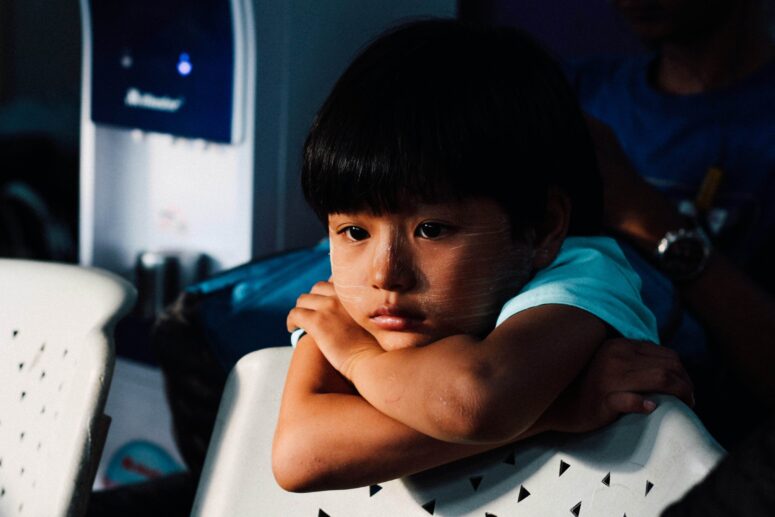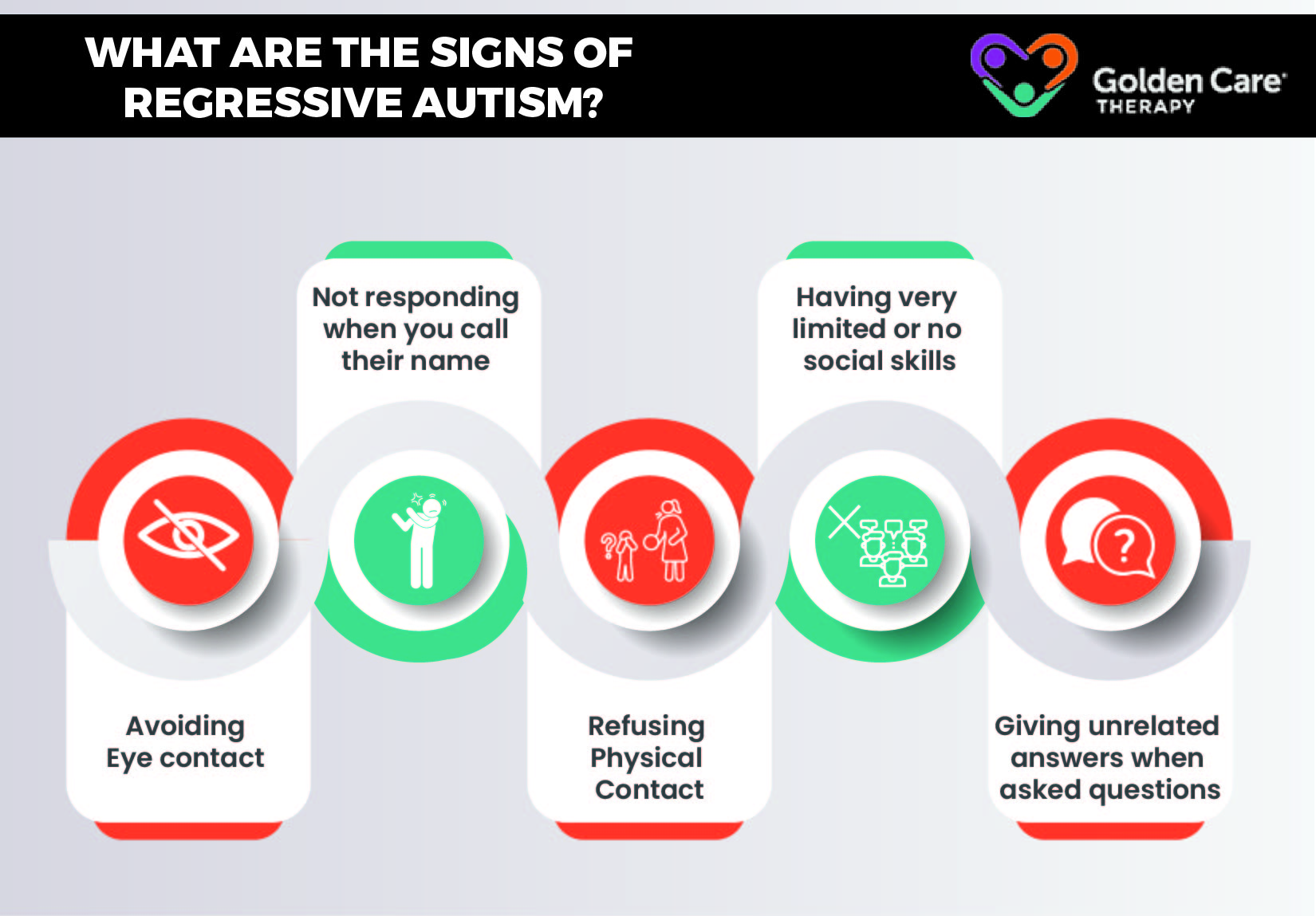
Table of Contents
Up to 50 percent of all autism diagnoses are considered to be of the regressive type, where a child seems to develop normally but then suddenly loses some of their acquired skills. One effective approach to addressing this is ABA therapy at home, which allows for a personalized and consistent intervention in a familiar environment.
In this article, we take a closer look at regressive autism and the therapies that are used to treat the condition.
What Is Regressive Autism?
Signs of autism spectrum disorder can be noticed already in six-months-old babies, although the condition is typically diagnosed after the age of four. Despite the presence of early symptoms like avoiding eye contact or lack of communication, diagnosing ASD can be challenging because there are no medical tests to confirm the disorder.
If your child seems to develop normally but all of a sudden loses their previously acquired abilities like verbal and nonverbal communication skills and starts following the standard autistic development pattern, he or she may have regressive autism. The onset of regressive autism is usually followed by a lengthy period of stagnation in skill development.
Regressive autism is also known as autistic regression, autism with regression, setback-type autism, as well as acquired autistic syndrome. It used to be classified as a subtype of autism. However, children who are diagnosed with regressive autism are now believed to have subtle symptoms even before the regression takes place.
Autism onset patterns
Autism can have several different onset patterns, including:
- Ordinary regression where there are no apparent delays before the loss of communication or other skills occurs.
- Regression where early delays are followed by loss of acquired skills.
- Early onset where early developmental delays occur, but they are not followed by loss of other skills.
- Plateau where the child fails to learn new skills, although there are no apparent early delays or later skill losses.
Regressive autism can take place very suddenly or gradually, but the child will in most cases have difficulties regaining the lost skills.
The Difference Between Autism That Develops and Regressive Autism
Autism That Develops (Early-Onset Autism)
Autism that develops, also known as early-onset autism, refers to cases where symptoms are present from an early age, often before the child turns three years old. Children with early-onset autism exhibit developmental delays and differences in social, communication, and behavioral skills compared to their typically developing peers.
Regressive Autism (Late-Onset Autism)
Regressive autism, also known as late-onset autism, involves a period of typical development followed by a loss of previously acquired skills or a noticeable decline in social and communication abilities. This regression usually occurs between 15 and 30 months of age and can be sudden or gradual.
What Is the Age When Regressive Autism Starts?
Regressive autism usually starts developing in toddlers between 15 and 30 months old. On average, it is diagnosed around 19 months.
What are the Signs of Regressive Autism?
The early signs of regressive autism include:
- Avoiding eye contact
- Not responding when you call the child’s name
- Repeating the exact words or phrases uttered by others, also known as echolalia
- Giving unrelated answers when asked questions
- Systematically using the pronoun “you” instead of “I”
- Not being interested in pointing at objects or toys
- Refusing physical contact
- Having very limited or no social skills
- Failure to understand their own feelings and those of other people.
There are many other signs and symptoms of regressive autism that are similar to typical ASD traits, for example:
- Repetitive behavior or stimming, such as flapping hands or spinning in circles
- Extreme anxiety
- Impulsive actions
- Hyperactive behavior
- Difficulty to accept changes routines and transitions into new situations
- Oversensitivity or under sensitivity to sounds, smell, taste, and touch
- Unusual eating habits and preference for certain types of foods
- Sleep regression
- Atypical interests and behaviors
- Playing always in the same way, for example lining cars or building blocks
- Obsessive interest in specific parts of objects, such as the wheels of toy cars.
How to Diagnose a Child With Regressive Autism?
Regressive autism is diagnosed in the same way as autism spectrum disorder in general. In other words, a multidisciplinary team that is composed of a psychologist, a speech pathologist, and a pediatrician or child psychiatrist will observe your child’s behavior, communication patterns, and interactions with others, in addition to looking into your child’s developmental history. Once the child is diagnosed with regressive autism, the team will develop a personalized treatment plan.
Can Regressive Autism Be Reversed?
There is no cure for autism. However, in many cases, children who are diagnosed early enough and go through rigorous therapy will acquire the necessary tools to improve their skills and function independently. It is important to keep in mind that every child is different, and progress will vary depending on the severity of the condition and other factors.
Below, we list some therapies that offer a targeted treatment of regressive autism based on your child’s individual needs.
Therapies for Children with Regressive Autism
Several behavioral and educational therapies and combinations of therapies have been proven effective in treating children diagnosed with regressive autism.
Applied behavioral analysis (ABA)
Applied behavior analysis (ABA) is a form of behavioral therapy developed by psychologist O. Ivar Lovaas in the 1970s. It has been successfully used in treating autistic children ever since. ABA therapy can help improve skills such as:
- Activities of daily living
- Potty training
- Following directions
- Understanding nonverbal communication, including facial expressions and body language
- Responding to questions
- Social skills and interacting with others
- Play skills
- Visual skills, for example, matching, sorting, and recognizing patterns
- Reducing problematic behaviors like tantrums.
ABA therapy is considered to be the most effective form of autism treatment, although it typically requires a strict regimen of at least 25 hours of therapy per week, and in some cases, up to 40 hours weekly. However, ABA has been proven successful in close to 90 percent of cases, where nearly half of the children see improvements so significant that their behavior is indistinguishable from that of neurotypical children.
How does it work?
ABA therapists break down each skill that needs to be improved into smaller steps. They can then gradually build toward larger and more complex tasks.
ABA focuses on changing unwanted behaviors while reinforcing the desirable ones. Therapists use rewards and praise as a method of positive reinforcement. At the same time, they ignore negative behaviors or distract the child from them. An ABA therapy session typically consists of a variety of fun activities and games, in addition to practicing adaptive skills. As a parent, you can also expect to be heavily involved in working on your child’s progress.
Sensory integration therapy
Sensory integration therapy was developed by occupational therapist A. Jean Ayres in the 1970s. It is designed to help children who are diagnosed with autism spectrum disorder cope with sensory processing difficulties.
Sensory processing dysfunction is one of the most common symptoms of autism. The dysfunction can manifest itself either as oversensitivity or under-sensitivity to light, sound, smell, taste, or touch. Typical behaviors of children who experience sensory issues are exaggerated movement including jumping or spinning, as well as stimming, such as hand flapping, or rocking.
How does it work?
Sensory integration therapy includes a range of activities that stimulate sensory responses, for example, swinging, bouncing, and climbing. The treatment can help autistic children better understand sensory information and learn how to use multiple senses simultaneously without becoming overwhelmed.
Sensory integration therapy is provided by occupational therapists. It is often combined with other treatments, like speech therapy, behavioral therapy, and educational therapy.
Speech therapy
Most autistic children have at least some level of communication issues. Some may have limited use of speech or no language at all. Speech therapy can help improve both verbal and nonverbal communication and interaction with others, including:
- Responding to questions
- Matching a picture with its meaning
- Strengthening the mouth, jaw, and neck muscles
- Learning how to make clearer speech sounds
- Modulating the tone of voice
- Matching emotions with the correct facial expression
- Learning nonverbal skills and body language.
How does it work?
Speech therapy is done by speech-language pathologists. For children with autism who are able to talk, speech therapy consists in encouraging functional and spontaneous communication in a variety of settings, as well as articulating therapy, oral motor therapy, or a combination of these methods.
On the other hand, autistic children with severe language problems will highly benefit from using augmentative and alternative communication (AAC) therapy. Sessions are dedicated to teaching the use of picture exchange communication systems (PECS), sign language, or speech output devices like DynaVox.
Vision therapy
Vision training is effective in helping children with autism feel less overwhelmed by visual stimuli and interact more easily with their environment. Vision training may lessen or totally eliminate some vision-related sensory issues. The treatment is also proven to be beneficial for improving posture, head-tilt, spatial awareness, and coordination in children with regressive autism.
The most common visual problems in autistic children include:
- Hypersensitive vision
- Light sensitivity
- Lack of eye contact
- Eye movement disorders
- Staring at spinning objects or light
- Fleeting peripheral glances
- Side viewing
- Crossed eyes
- Visual stimming, such as flapping fingers in front of eyes
- Visual defensiveness or avoiding contact with specific visual input like bright lights.
How does it work?
Vision training is done by a vision therapist who uses a variety of exercises to stimulate eye movement and the use of the central visual system. The child might need to wear ambient prism lenses during the session. Some typical autistic behaviors related to the eyes like poor eye contact, looking through or beyond objects, extreme aversion to light, unusual reaction to sight can be effectively treated through vision therapy using this type of lenses.
Auditory integration training (AIT)
Developed by French ear, nose, and throat doctor Dr. Guy Berard, Auditory Integration Training (AIT) is a type of sound therapy whose aim is to reduce auditory sensitivity issues in autistic children. This therapy addresses hearing distortions, oversensitive hearing, and other issues related to processing sounds that may cause discomfort and confusion. AIT not only effectively retrains hearing and improves auditory processing, but it also enhances concentration, speech, and language skills.
How does it work?
Auditory integration training usually lasts for two weeks with two 30-minute daily sessions. The sessions involve listening to specialized music through headphones, first by presenting familiar sounds to then transition to more challenging ones with a high or low frequency. This way, children can gradually get used to the sounds until they no longer represent a problem.
Although some therapists are certified Berard AIT practitioners, no formal qualification is required to provide this type of therapy and it is usually offered by speech and language pathologists or occupational therapists.
Other types of sound therapy
Besides auditory integration training, there are several other forms of sound therapy available to autistic children. All of them are based on strengthening the foundation of a child’s neurological functioning, including auditory processing and attention.
The Tomatis approach
The Tomatis approach is designed to improve listening, speech, and communication skills in autistic children, in addition to reinforcing balance and coordination. The child uses headphones to listen to electronically modified music and other sounds. This treatment exercises the muscles in the ear and stimulates connections between the ear and the brain.
The Samonas Sound Therapy (SST)
Samonas sound therapy is based on using therapeutic music to provide direct stimulation to the child’s central nervous system and train the auditory system to process the full range of sounds without experiencing distortion, hypersensitivity, or frequency loss.
The Listening Program (TLP)
TLP is music-based therapy that provides auditory stimulation through psychoacoustically modified classical music. TLP can be used as a stand-alone intervention or integrated with other treatments such as ABA therapy, occupational therapy, speech therapy, and neurodevelopmental programs.
Continue reading for a list of resources that you may find useful if your child has been diagnosed with regressive autism.
Tools for Parents to Cope With Regressive Autism
Associations
- Autism Speaks is the largest autism awareness organization in the country. It is a good starting point if you need to find information about any aspect of autism, from signs and symptoms to diagnoses and treatments.
- National Autism Association (NAA) is a parent-run non-profit organization. The NNA website provides comprehensive information on issues related specifically to regressive autism, but also topics such as severe autism, autism safety, autism abuse, and crisis prevention.
- Sibling’s Guide to Autism from Autism Speaks explains the condition to siblings and tells stories of other families with an autistic child.
Support groups
- MyAutismTeam is a social network for parents of children with autism where you can connect with other parents, receive emotional support, and share your experience about caring for an autistic child.
- Autism Support Groups are where you can meet others in a similar situation as well as join after-school clubs and activities.
Communication tools
- Social stories can help children with autism spectrum disorder improve their communication and social skills. Many social story templates are available for free download on this website.
- Noodle Nook is a space dedicated to educators of children with autism and other disabilities. It offers plenty of useful information on communication and other topics, in addition to a dedicated YouTube channel and a podcast. Here you can download Autism Communication Boards and other printable resources for free.
Apps
- Language Therapy for Children with Autism is among the most popular autism apps. It uses the Mental Imagery Therapy for Autism (MITA) approach to help children with autism reach language development milestones and start speaking confidently.
- CommBoards Lite – AAC Speech Assistant is an Android app that serves as a communication board. It can help children with limited verbal abilities communicate with others. When a child taps on an image, they will hear the word pronunciation, which can help them verbalize their thoughts. You can record your own words and add your images for a personalized experience.
If you are ready to work with the best ABA therapy provider in New York, New Jersey or Indiana, give us a call at (732) 402-0297. Our dedicated team is ready to help and we will treat you like family.
- Autism Routine Disruption in Adults: Coping Tips - July 16, 2024
- Autism and Obsession: An Overview - July 16, 2024
- Autism and Taking Clothes Off: Management Tips - July 16, 2024


